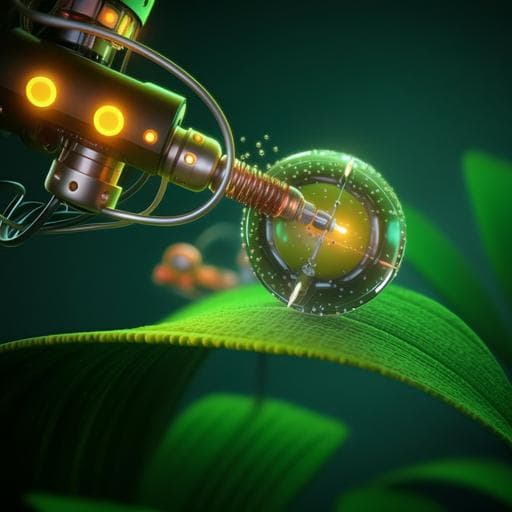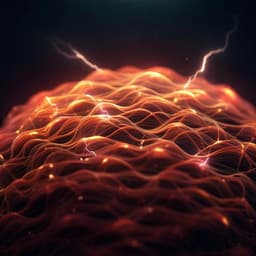
Engineering and Technology
Plant-like hooked miniature machines for on-leaf sensing and delivery
I. Fiorello, F. Meder, et al.
This groundbreaking research by Isabella Fiorello and colleagues explores the creation of miniature machines inspired by *Galium aparine* for innovative on-leaf sensing and delivery. Discover how multifunctional microhooks and soft robotics are paving the way for precision in plant ecosystem applications!
~3 min • Beginner • English
Introduction
The study addresses the challenge of noninvasively attaching devices to fragile, heterogeneous leaf surfaces for on-site sensing and delivery in natural and agricultural environments. Existing leaf-mounted devices often rely on glues or clips and can damage tissues, and microneedles are being explored for delivery and diagnostics. Inspired by the reversible, shear-dependent anchoring of the hook-climber Galium aparine, the authors hypothesize that bioinspired microhooks can provide strong, directional, reversible attachment to diverse leaf surfaces, enabling multifunctional miniature machines for in situ monitoring, delivery, and mobility on leaves. The work aims to design, fabricate, and characterize such microhook-based devices, correlate attachment performance with leaf microstructure and mechanics, and demonstrate applications including a wireless origami-assembled leaf microclimate sensor, dissolvable delivery hooks, and a soft robot exhibiting ratchet-like motion on leaves. The broader significance lies in advancing precision tools for plant ecosystem monitoring and preservation while minimizing environmental impact.
Literature Review
The paper situates its contributions within prior work on plant sensing and delivery: glue- or clip-based leaf sensors for monitoring water content, temperature, growth, and stress; microneedle patches for payload delivery and rapid disease detection; and bioinspired soft machines operating in natural environments. It reviews plant anchoring strategies (spines, prickles, microhooks, burrs) and highlights Galium aparine’s microscopic hooks enabling reversible, ratchet-like interlocking with host leaves. Previous work by the authors demonstrated microhook-inspired attachment to textiles and skin using two-photon lithography. Compared to other artificial leaf interlocking strategies (e.g., microneedles), microhooks promise high shear-dependent anchoring with reversible, direction-based engagement/disengagement, and multifunctionality (attachment, sensing, delivery, locomotion).
Methodology
Concept and design: Artificial abaxial microhooks inspired by Galium aparine were designed (geometry detailed in supplementary material) to create two device types: flexible IPS-made microhook devices (IPS-MHDs) and self-dissolving isomalt@fluorescein microhook devices (i@fluo-MHDs).
Fabrication:
- IPS-MHDs: Two-photon lithography (Nanoscribe Photonic Professional) directly printed IPS photoresist hooks on flexible PET (Mylar) sheets. Standard development in PGMEA, rinsing, and drying. Arrays typically 5×5 hooks (156 hooks cm−2), with variations in hook density (49, 156, 352 hooks cm−2) by changing inter-hook spacing; and hook size scaling (0.5×, 1×, 2×).
- i@fluo-MHDs: Two-step process combining two-photon lithography (master in IP-Q on Si) and PDMS mold making. Casting heated isomalt mixed with fluorescein into PDMS molds under pressure/heat. For higher throughput, PCL replicas were made to create a multi-replica master for multiple isomalt castings.
Leaf classification and characterization:
- Surfaces: Smooth (young and mature Magnolia grandiflora adaxial) and rough (convex epidermal cells with/without hairs) including Hedera helix, Arum italicum, Vitis vinifera, Vitis lambrusca adaxial/abaxial, and Rubus caesius adaxial/abaxial with varying hair densities and types (erect vs helicoidal).
- Roughness: 3D optical profilometry (Leica DCM 3D) at ×10 and ×50 to obtain average roughness (Sa/Ra).
- Mechanics: Dynamic nanoindentation (iNano) with flat punch to estimate local tissue modulus E over 1–200 Hz on fresh samples.
- Imaging: Light microscopy, SEM, and FIB-SEM for hook-leaf interaction and penetration cross-sections.
Attachment testing:
- Custom multiaxis platform measured pull-off, shear-locking, and sliding friction forces. Fresh leaf pieces were fixed, devices mounted, and a preload applied for pull-off and shear-locking. Protocols:
- Pull-off: 1 N preload unless noted; 500 µm horizontal displacement against hook direction to engage; vertical retraction at 0.5 mm s−1; maximum force recorded. Lower preloads (0.05 N, 0.02 N) assessed.
- Shear-locking: 1 N preload; 5 mm horizontal pull against hook direction; maximum force peaks recorded.
- Friction: No preload (natural-like); 10 mm horizontal pull at 0.2 mm s−1 against hook direction; mean of five force peaks used.
- Tested multiple species/surfaces; at least five samples per condition; ANOVA with Tukey post-hoc for statistics.
Dissolution and delivery studies:
- i@fluo-MHDs interlocked into V. lambrusca leaves for ~3 min; fluorescence microscopy tracked fluorescein movement in vascular tissues after device removal; in vitro dissolution in water at room temperature and response at single-hook level to humidity and direct water exposure recorded.
Environmental demonstrators:
- Origami-assembled wireless multiparameter sensor: PET sheet with aligned microprinted IPS hooks folded into 3D structure; Kapton-based PCB with Bluetooth MCU (CYBLE-014008-00), RGBW light sensor (VEML6040), and two T/H sensors (SHT21) positioned for adaxial and abaxial measurements; wireless data logging; device mass ~2.6 g.
- Dissolvable delivery patches: i@fluo-MHDs for molecular delivery demonstration on grapevine leaves.
- MH-based MiniBot: PET structure with two arrays of 3×10 IPS hooks on feet; actuated by a soft multiphase actuator driven by an 808 nm NIR laser (~250–500 mW). Forward locomotion characterized on V. lambrusca leaves using synchronized video and thermal imaging.
Computational modeling:
- 3D finite element model (COMSOL) of initial hook extraction from a composite leaf (upper/lower epidermis 20 µm, E=13 MPa; mesophyll 200 µm, E=0.8 MPa) with IPS hook (E=4.6 GPa) to assess local interaction and effects of hook size.
- Simplified 2D penetration model to study preload-per-spine vs penetration depth and hook density effects on penetration and subsequent pull-off forces.
Electronics and power:
- Active state consumption ~3.33 mA@4.2 V for ~198 ms per cycle; sleep ~20.4 µA; 30 s sampling period yields ~50 days runtime with 50 mAh LiPo.
Key Findings
- Directional, reversible microhook anchoring achieved across diverse leaf surfaces. IPS-MHDs generated high shear-locking forces up to 10.4 ± 2.0 N cm−2 (helicoidal hairy surfaces) and 5.9 ± 1.4 N cm−2 on smooth surfaces at 1 N preload.
- Pull-off forces increased with surface roughness: 0.6 ± 0.2 N cm−2 (smooth) to 1.1 ± 0.2 N cm−2 (rough without hairs) and 1.3 ± 0.4 N cm−2 (rough with helicoidal hairs) at 1 N preload.
- Friction (no preload) correlated with roughness; helicoidal hairs strongly enhanced friction to 0.24 ± 0.05 N cm−2; high-density erect hairs reduced friction due to screening when penetration did not occur.
- Preload dependence: Lower preload (0.05 N) reduced attachment; at 0.02 N, detachment forces were negligible, indicating penetration/engagement thresholds.
- Leaf mechanics: Hooks attached on fresh leaves with E up to ~73 ± 18 MPa (young Magnolia), but failed on very stiff mature Magnolia (E up to 128 ± 43 MPa) due to insufficient penetration.
- i@fluo-MHDs achieved pull-off of 0.5 ± 0.2 N cm−2 and shear-locking of 3.4 ± 0.6 N cm−2 on V. lambrusca, demonstrating capability of dissolvable hooks for on-leaf work.
- Hook density effects: Relative to 156 hooks cm−2, both reduced (49 hooks cm−2) and increased density (352 hooks cm−2) yielded weaker attachments at a given preload. Modeling indicated higher densities hamper penetration more than proportionally, reducing subsequent pull-off forces due to tissue compression and reduced effective engagement.
- Hook size effects: 0.5× hooks failed to engage; 2× hooks anchored with forces comparable to 1×. Modeling suggested extraction force scales sub-linearly with size due to stiffness contrasts and interface effects.
- Delivery and dissolution: i@fluo-MHDs rapidly dissolved in water (<10 min). Single-hook tips dissolved in ~10 s upon direct water contact; partial dissolution under ambient humidity over ~150 min. Fluorescein signal decreased at injection sites and increased over time in distal vascular tissues (veins), indicating absorption and transport (e.g., via phloem).
- Environmental demonstrators:
- Origami wireless sensor (2.6 g) securely attached to leaves, monitored adaxial/abaxial temperature, humidity, and light over 16 h; robust in windy conditions; battery life ~50 days at 30 s sampling.
- No evident short-term adverse leaf effects after isomalt hook injection; localized scars self-healed.
- MH-based MiniBot (190 mg) achieved ratchet-like forward locomotion on leaf surfaces under NIR-driven actuation without additional preload.
- Comparative advantage: The microhook strategy provides high shear-dependent anchoring (up to ~10.4 N cm−2) and reversible engagement/disengagement by load direction, surpassing other artificial interlocking approaches while enabling multifunctionality (sensing, delivery, locomotion).
Discussion
The findings validate the central hypothesis that Galium aparine–inspired microhooks provide strong, directional, and reversible attachment to a range of leaf surfaces, enabling multifunctional on-leaf machines. Quantitative tests linked performance to leaf microstructure (roughness, hair type) and mechanics (local stiffness), clarifying when and how penetration and interlocking occur. High shear-locking forces and direction-dependent engagement allow robust anchoring during sensing or locomotion and easy detachment by reversing load direction, minimizing leaf damage. Dissolvable isomalt hooks proved mechanically capable for shear-induced penetration and rapidly released molecular cargo into vascular tissues, suggesting a minimally invasive, biodegradable delivery modality. The origami-assembled sensor showcased practical, reusable, wireless monitoring of adaxial/abaxial microclimate parameters relevant to plant health management, while the MiniBot demonstrated that microhook arrays can enable ratchet-like locomotion on compliant, heterogeneous leaf substrates. Modeling provided mechanistic insights: excessive hook density can reduce penetration efficacy by compressing the epidermis and limiting local engagement; modest upscaling preserves performance but with sub-linear force gains due to stiffness mismatches. Overall, the microhook approach opens avenues for precision agriculture and ecosystem monitoring, with on-leaf devices that can securely attach, sense, deliver, and move in an environmentally compatible manner.
Conclusion
The study introduces a plant-inspired, multifunctional microhook platform that achieves strong, directional, and reversible anchoring on diverse leaf surfaces. It demonstrates three key capabilities: (i) a reusable, wireless origami-assembled sensor for simultaneous adaxial/abaxial microclimate monitoring; (ii) biodegradable, dissolvable hooks for localized, rapid molecular delivery into vascular tissues; and (iii) a proof-of-concept soft robot exhibiting ratchet-like motion on leaves. Together, these results highlight a path toward miniature machines for precision forestry and agriculture, enabling in situ monitoring and targeted interventions while minimizing environmental impact. Future work should optimize hook array mechanics (density, distribution, load-sharing), identify and test suitable cargos and protective coatings for controlled dissolution, investigate long-term plant responses, and address integration challenges (manufacturing, sensing, actuation, power, control) for robust field deployment and mobile operation in complex vegetation.
Limitations
- Mechanical limits: Hooks could not attach to very stiff leaf tissues (e.g., mature Magnolia grandiflora, E up to 128 ± 43 MPa), indicating constraints based on tissue stiffness and required preload.
- Preload sensitivity: Effective engagement requires sufficient preload; at very low preloads (e.g., 0.02 N) detachment forces were negligible, complicating uncontrolled field conditions.
- Hook density trade-offs: Increased density can hinder penetration and reduce net attachment due to tissue compression and limited local engagement; optimal array designs need further study.
- Modeling simplifications: Computational models addressed only initial extraction and simplified penetration with limited biological data; fracture, heterogeneity, and load-sharing among hooks were not fully captured.
- Biological response: Long-term plant physiological responses to isomalt hook injections and various cargos remain to be investigated; only short-term, localized effects were assessed.
- Environmental durability: Dissolvable hooks are sensitive to humidity/water; protective coatings may be required to tailor dissolution timing for field use.
- Robotic deployment: The MiniBot is a proof-of-concept; robust operation in outdoor environments (wind, rain, temperature variations) and integration of onboard power/control require further development.
Related Publications
Explore these studies to deepen your understanding of the subject.







